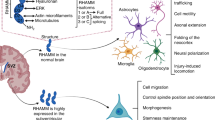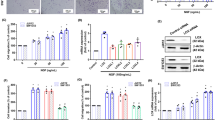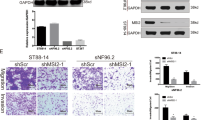Abstract
Mutation or loss of expression of merlin is responsible for neurofibromatosis type 2 (NF2), which is characterized by the development of schwannomas and other tumors of the nervous system. Like the ERM (ezrin-radixin-moesin) proteins, merlin interacts with CD44, a cell-surface receptor for hyaluronan (HA) that promotes tumorigenesis. However, the relationship between merlin and CD44 and the mechanism by which merlin exerts its tumor-suppressor function have not been elucidated. In the present study, we show that increased expression of wild-type merlin in Tr6BC1 schwannoma cells inhibits HA binding to CD44. Furthermore, we demonstrate that the residues required for this inhibitory effect and the interaction between CD44 and merlin lie within the first 50 amino acids of merlin. Overexpression of merlin inhibited subcutaneous growth of Tr6BC1 cells in immunocompromised Rag1 mice. In contrast, knocking down expression of endogenous merlin promoted tumor cell growth, as did overexpression of a merlin deletion mutant (merlinDel-1) that lacks the first 50 amino acids but not of other NH2-terminal deletion mutants. Together, our results demonstrate that inhibition of the CD44-HA interaction contributes to the tumor-suppressor function of merlin, and they suggest that merlin inhibits tumor growth, at least in part, by negatively regulating CD44 function.
This is a preview of subscription content, access via your institution
Access options
Subscribe to this journal
Receive 50 print issues and online access
$259.00 per year
only $5.18 per issue
Buy this article
- Purchase on Springer Link
- Instant access to full article PDF
Prices may be subject to local taxes which are calculated during checkout









Similar content being viewed by others
References
Algrain M, Turunen O, Vaheri A, Louvard D, Arpin M . (1993). Ezrin contains cytoskeleton and membrane binding domains accounting for its proposed role as a membrane-cytoskeletal linker. J Cell Biol 120: 129–140.
Aruffo A, Stamenkovic I, Melnick M, Underhill CB, Seed B . (1990). CD44 is the principal cell surface receptor for hyaluronate. Cell 61: 1303–1313.
Bianchi AB, Hara T, Ramesh V, Gao J, Klein-Szanto AJ, Morin F et al. (1994). Mutations in transcript isoforms of the neurofibromatosis 2 gene in multiple human tumour types. Nat Genet 6: 185–192.
Chan HM, Narita M, Lowe SW, Livingston DM . (2005). The p400 E1A-associated protein is a novel component of the p53 --> p21 senescence pathway. Genes Dev 19: 196–201.
Deguen B, Merel P, Goutebroze L, Giovannini M, Reggio H, Arpin M et al. (1998). Impaired interaction of naturally occurring mutant NF2 protein with actin-based cytoskeleton and membrane. Hum Mol Genet 7: 217–226.
Evans DG, Huson SM, Donnai D, Neary W, Blair V, Newton V et al. (1992). A clinical study of type 2 neurofibromatosis. Q J Med 84: 603–618.
Evans DG, Trueman L, Wallace A, Collins S, Strachan T . (1998). Genotype/phenotype correlations in type 2 neurofibromatosis (NF2): evidence for more severe disease associated with truncating mutations. J Med Genet 35: 450–455.
Giovannini M, Robanus-Maandag E, Niwa-kawakita M, van der Valk M, Woodruff JM, Goutebroze L et al. (1999). Schwann cell hyperplasia and tumors in transgenic mice expressing a naturally occurring mutant NF2 protein. Genes Dev 13: 978–986.
Giovannini M, Robanus-Maandag E, van der Valk M, Niwa-Kawakita M, Abramowski V, Goutebroze L et al. (2000). Conditional biallelic Nf2 mutation in the mouse promotes manifestations of human neurofibromatosis type 2. Genes Dev 14: 1617–1630.
Gunthert U, Hofmann M, Rudy W, Reber S, Zoller M, Haussmann I et al. (1991). A new variant of glycoprotein CD44 confers metastatic potential to rat carcinoma cells. Cell 65: 13–24.
Gutmann DH . (1994). New insights into the neurofibromatoses. Curr Opin Neurol 7: 166–171.
Gutmann DH, Giordano MJ, Fishback AS, Guha A . (1997). Loss of merlin expression in sporadic meningiomas, ependymomas and schwannomas. Neurology 49: 267–270.
Gutmann DH, Haipek CA, Lu KH . (1999a). Neurofibromatosis 2 tumor suppressor protein, merlin, forms two functionally important intramolecular associations. J Neurosci Res 58: 706–716.
Gutmann DH, Sherman L, Seftor L, Haipek C, Lu KH, Hendrix M . (1999b). Increased expression of the NF2 tumor suppressor gene product, merlin, impairs cell motility, adhesionand spreading. Hum Mol Genet 8: 267–275.
Hannon GJ, Conklin DS . (2004). RNA interference by short hairpin RNAs expressed in vertebrate cells. Methods Mol Biol 257: 255–266.
Hara T, Bianchi AB, Seizinger BR, Kley N . (1994). Molecular cloning and characterization of alternatively spliced transcripts of the mouse neurofibromatosis 2 gene. Cancer Res 54: 330–335.
Hemann MT, Fridman JS, Zilfou JT, Hernando E, Paddison PJ, Cordon-Cardo C et al. (2003). Mutations in transcript isoforms of the neurofibromatosis 2 gene in multiple human tumour types. Nat Genet 33: 396–400.
Hirao M, Sato N, Kondo T, Yonemura S, Monden M, Sasaki T et al. (1996). Regulation mechanism of ERM (ezrin/radixin/moesin) protein/plasma membrane association: possible involvement of phosphatidylinositol turnover and Rho-dependent signaling pathway. J Cell Biol 135: 37–52.
Huynh DP, Pulst SM . (1996). Neurofibromatosis 2 antisense oligodeoxynucleotides induce reversible inhibition of schwannomin synthesis and cell adhesion in STS26T and T98G cells. Oncogene 13: 73–84.
Kang BS, Cooper DR, Devedjiev Y, Derewenda U, Derewenda ZS . (2002). The structure of the FERM domain of merlin, the neurofibromatosis type 2 gene product. Acta Crystallogr D Biol Crystallogr 58: 381–391.
Khanna C, Khan J, Nguyen P, Prehn J, Caylor J, Yeung C et al. (2001). Metastasis-associated differences in gene expression in a murine model of osteosarcoma. Cancer Res 61: 3750–3759.
Khanna C, Wan X, Bose S, Cassaday R, Olomu O, Mendoza A et al. (2004). The membrane-cytoskeleton linker ezrin is necessary for osteosarcoma metastasis. Nat Med 10: 182–186.
Kissil JL, Wilker EW, Johnson KC, Eckman MS, Yaffe MB, Jacks T . (2003). Merlin, the product of the Nf2 tumor suppressor gene, is an inhibitor of the p21-activated kinase, Pak1. Mol Cell 12: 841–849.
Koga H, Araki N, Takeshima H, Nishi T, Hirota T, Kimura Y et al. (1998). Impairment of cell adhesion by expression of the mutant neurofibromatosis type 2 (NF2) genes which lack exons in the ERM-homology domain. Oncogene 17: 801–810.
LaJeunesse DR, McCartney BM, Fehon RG . (1998). Structural analysis of Drosophila merlin reveals functional domains important for growth control and subcellular localization. J Cell Biol 141: 1589–1599.
Lallemand D, Curto M, Saotome I, Giovannini M, McClatchey AI . (2003). NF2 deficiency promotes tumorigenesis and metastasis by destabilizing adherens junctions. Genes Dev 17: 1090–1100.
Lamb RF, Hennigan RF, Turnbull K, Katsanakis KD, MacKenzie ED, Birnie GD et al. (1997). AP-1-mediated invasion requires increased expression of the hyaluronan receptor CD44. Mol Cell Biol 17: 963–976.
Lesley J, Hyman R, Kincade P . (1993). CD44 and its interaction with extracellular matrix. Adv Immunol 54: 271–335.
Lutchman M, Rouleau GA . (1995). The neurofibromatosis type 2 gene product, schwannomin, suppresses growth of NIH 3T3 cells. Cancer Res 55: 2270–2274.
Martin TA, Harrison G, Mansel RE, Jiang WG . (2003). The role of the CD44/ezrin complex in cancer metastasis. Crit Rev Oncol Hematol 46: 165–186.
McClatchey AI, Giovannini M . (2005). Membrane organization and tumorigenesis–the NF2 tumor suppressor, merlin. Gene & Dev 19: 2265–2277.
McClatchey AI, Saotome I, Mercer K, Crowley D, Gusella JF, Bronson RT et al. (1998). Mice heterozygous for a mutation at the Nf2 tumor suppressor locus develop a range of highly metastatic tumors. Genes Dev 12: 1121–1133.
Merel P, Hoang-Xuan K, Sanson M, Bijlsma E, Rouleau G, Laurent-Puig P et al. (1995). Screening for germ-line mutations in the NF2 gene. Genes Chromosomes Cancer 12: 117–127.
Morrison H, Sherman LS, Legg J, Banine F, Isacke C, Haipek CA et al. (2001). The NF2 tumor suppressor gene product, merlin, mediates contact inhibition of growth through interactions with CD44. Genes Dev 15: 968–980.
Murthy A, Gonzalez-Agosti C, Cordero E, Pinney D, Candia C, Solomon F et al. (1998). NHE-RF, a regulatory cofactor for Na(+)-H+ exchange, is a common interactor for merlin and ERM (MERM) proteins. J Biol Chem 273: 1273–1276.
Nigro JM, Baker SJ, Preisinger AC, Jessup JM, Hostetter R, Cleary K et al. (1989). Mutations in the p53 gene occur in diverse human tumour types. Nature 342: 705–708.
Obremski VJ, Hall AM, Fernandez-Valle C . (1998). Merlin, the neurofibromatosis type 2 gene product, and beta1 integrin associate in isolated and differentiating Schwann cells. J Neurobiol 37: 487–501.
Okada T, Lopez-Lago M, Giancotti FG . (2005). Merlin/NF-2 mediates contact inhibition of growth by suppressing recruitment of Rac to the plasma membrane. J Cell Biol 171: 361–371.
Okamoto I, Kawano Y, Murakami D, Sasayama T, Araki N, Miki T et al. (2001). Proteolytic release of CD44 intracellular domain and its role in the CD44 signaling pathway. J Cell Biol 155: 755–762.
Oliferenko S, Paiha K, Harder T, Gerke V, Schwarzler C, Schwarz H et al. (1999). Analysis of CD44-containing lipid rafts: Recruitment of annexin II and stabilization by the actin cytoskeleton. J Cell Biol 146: 843–854.
Paddison PJ, Caudy AA, Sachidanandam R, Hannon GJ . (2004). Short hairpin activated gene silencing in mammalian cells. Methods Mol Biol 265: 85–100.
Parry DM, MacCollin MM, Kaiser-Kupfer MI, Pulaski K, Nicholson HS, Bolesta M et al. (1996). Germ-line mutations in the neurofibromatosis 2 gene: correlations with disease severity and retinal abnormalities. Am J Hum Genet 59: 529–539.
Pelton PD, Sherman LS, Rizvi TA, Marchionni MA, Wood P, Friedman RA et al. (1998). Ruffling membrane, stress fiber, cell spreading and proliferation abnormalities in human Schwannoma cells. Oncogene 17: 2195–2209.
Rong R, Surace EI, Haipek CA, Gutmann DH, Ye K. . (2004). Serine 518 phosphorylation modulates merlin intramolecular association and binding to critical effectors important for NF2 growth suppression. Oncogene 4: 1–8.
Rouleau GA, Merel P, Lutchman M, Sanson M, Zucman J, Marineau C et al. (1993). Alteration in a new gene encoding a putative membrane-organizing protein causes neuro-fibromatosis type 2. Nature 363: 515–521.
Ruttledge MH, Andermann AA, Phelan CM, Claudio JO, Han FY, Chretien N et al. (1996). Type of mutation in the neurofibromatosis type 2 gene (NF2) frequently determines severity of disease. Am J Hum Genet 59: 331–342.
Sainio M, Zhao F, Heiska L, Turunen O, den Bakker M, Zwarthoff E et al. (1997). Neurofibromatosis 2 tumor suppressor protein colocalizes with ezrin and CD44 and associates with actin-containing cytoskeleton. J Cell Sci 110: 2249–2260.
Scoles DR, Huynh DP, Morcos PA, Coulsell ER, Robinson NG, Tamanoi F et al. (1998). Neurofibromatosis 2 tumour suppressor schwannomin interacts with betaII-spectrin. Nat Genet 18: 354–359.
Screaton GR, Bell MV, Bell JI, Jackson DG . (1993). The identification of a new alternative exon with highly restricted tissue expression in transcripts encoding the mouse Pgp-1 (CD44) homing receptor: comparison of all 10 variable exons between mouse, human, and rat. J Biol Chem 268: 12235–12238.
Screaton GR, Bell MV, Jackson DG, Cornelis FB, Gerth U, Bell JI . (1992). Genomic structure of DNA encoding the lymphocyte homing receptor CD44 reveals at least 12 alternatively spliced exons. Proc Natl Acad Sci USA 89: 12160–12164.
Shaw RJ, Paez JG, Curto M, Yaktine A, Pruitt WM, Saotome I et al. (2001). The Nf2 tumor suppressor, merlin, functions in Rac-dependent signaling. Dev Cell 1: 63–72.
Sherman L, Sleeman J, Herrlich P, Ponta H . (1994). Hyaluronate receptors: key players in growth, differentiation, migration and tumor progression. Curr Opin Cell Biol 6: 726–733.
Sherman L, Xu HM, Geist RT, Saporito-Irwin S, Howells N, Ponta H et al. (1997). Interdomain binding mediates tumor growth suppression by the NF2 gene product. Oncogene 15: 2505–2509.
Shimizu T, Seto A, Maita N, Hamada K, Tsukita S, Tsukita S et al. (2002). Structural basis for neurofibromatosis type 2. Crystal structure of the merlin FERM domain. J Biol Chem 277: 10332–10336.
Stamenkovic I . (2000). Matrix metalloproteinases in tumor invasion and metastasis. Semin Cancer Biol 10: 415–433.
Stamenkovic I, Amiot M, Pesando JM, Seed B . (1989). A lymphocyte molecule implicated in lymph node homing is a member of the cartilage link protein family. Cell 56: 1057–1062.
Stickney JT, Bacon WC, Rojas M, Ratner N, Ip W . (2004). Activation of the tumor suppressor merlin modulates its interaction with lipid rafts. Cancer Res 64: 2717–2724.
Trofatter JA, MacCollin MM, Rutter JL, Murrell JR, Duyao MP, Parry DM et al. (1993). A novel moesin-, ezrin-, radixin-like gene is a candidate for the neurofibromatosis 2 tumor suppressor. Cell 72: 1–20.
Tsukita S, Oishi K, Sato N, Sagara J, Kamai A, Tsukita S . (1994). ERM family members as molecular linkers between the cell surface glycoprotein CD44 and actin-based cytoskeletons. J Cell Biol 126: 391–401.
Tsukita S, Yonemura S . (1997). ERM (ezrin/radixin/moesin) family: from cytoskeleton to signal transduction. Current Opin Cell Biol 9: 70–75.
Yonemura S, Hirao M, Doi Y, Takahashi N, Kondo T, Tsukita S et al. (1998). Ezrin/radixin/moesin (ERM) proteins bind to a positively charged amino acid cluster in the juxta-membrane cytoplasmic domain of CD44, CD43, and ICAM-2. J Cell Biol 140: 885–895.
Yu Q, Toole BP, Stamenkovic I . (1997). Induction of apoptosis of metastatic mammary carcinoma cells in vivo by disruption of tumor cell surface CD44 function. J Exp Med 186: 1985–1996.
Yu Q, Stamenkovic I . (1999). Localization of matrix metalloproteinase 9 to the cell surface provides a mechanism for CD44-mediated tumor invasion. Genes Dev 13: 35–48.
Yu Q, Stamenkovic I . (2000). Cell surface-localized matrix metalloproteinase-9 proteolytically activates TGF-beta and promotes tumor invasion and angiogenesis. Genes Dev 14: 163–176.
Yu Q, Stamenkovic I . (2001). Angiopoietin-2 is implicated in the regulation of tumor angiogenesis. Am J Pathol 158: 563–570.
Yu Y, Khan J, Khanna C, Helman L, Meltzer PS, Merlino G. . (2004). Expression profiling identifies the cytoskeletal organizer ezrin and the developmental homeoprotein Six-1 as key metastatic regulators. Nat Med 10: 175–181.
Xu Y, Yu Q . (2003). E-cadherin negatively regulates CD44-hyaluronan interaction and CD44-mediated tumor invasion and branching morphogenesis. J Biol Chem 278: 8661–8668.
Zoltan-Jones A, Huang L, Ghatak S, Toole BP . (2003). Elevated hyaluronan production induces mesenchymal and transformed properties in epithelial cells. J Biol Chem 278: 45801–45810.
Acknowledgements
We thank Dr Deborah McClellan for excellent editorial assistance. This work was supported by the DOD-U.S. Army Medical Research (DAMD17-02-1-0650, W81XWH-05-1-0191 and W81XWH-06-1-0246 to QY). IS is supported by a grant from the Swiss National Scientific Research Foundation and the Molecular Oncology NCCR.
Author information
Authors and Affiliations
Corresponding author
Rights and permissions
About this article
Cite this article
Bai, Y., Liu, Yj., Wang, H. et al. Inhibition of the hyaluronan-CD44 interaction by merlin contributes to the tumor-suppressor activity of merlin. Oncogene 26, 836–850 (2007). https://doi.org/10.1038/sj.onc.1209849
Received:
Revised:
Accepted:
Published:
Issue Date:
DOI: https://doi.org/10.1038/sj.onc.1209849
Keywords
This article is cited by
-
The genetic landscape and possible therapeutics of neurofibromatosis type 2
Cancer Cell International (2023)
-
Molecular Alterations in Malignant Pleural Mesothelioma: A Hope for Effective Treatment by Targeting YAP
Targeted Oncology (2022)
-
Cerebrospinal Fluid Hyaluronan and Neurofibromatosis Type 2
Cancer Microenvironment (2018)
-
Role of Merlin/NF2 inactivation in tumor biology
Oncogene (2016)
-
Dual role of CD44 isoforms in ampullary adenocarcinoma: CD44s predicts poor prognosis in early cancer and CD44ν is an indicator for recurrence in advanced cancer
BMC Cancer (2015)



